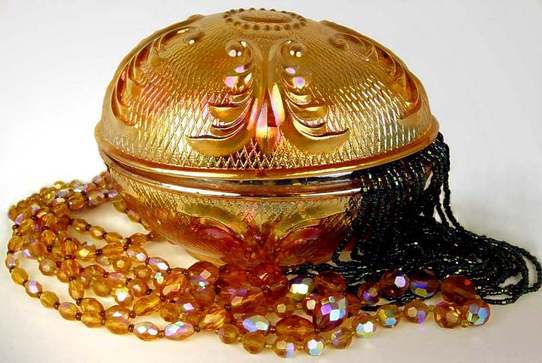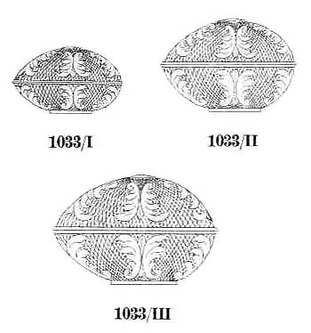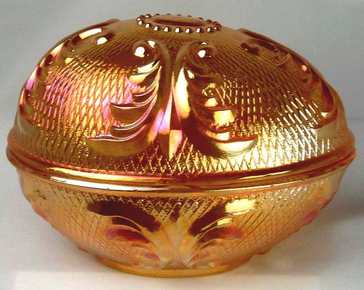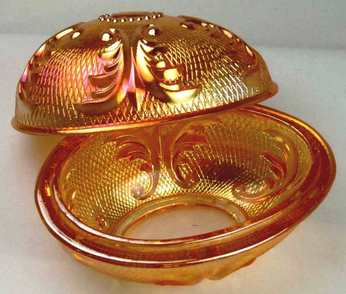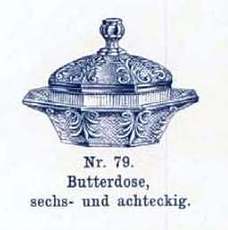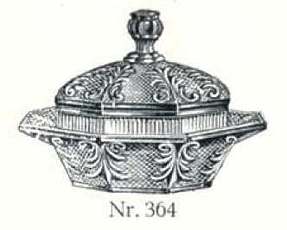Collectors Facts - Renaissance, Zabkowice, Poland
|
Shapes:
Bonbonnière
Covered Butter, 2 sizes
|
Colours:
Marigold
Marigold
|
This delightful covered bonbonnière is the first egg-shaped (oval) Carnival Glass item we have seen, and it was surely intended to be filled with some form of surprise treasure (edible or otherwise) at Easter. Filled with Carnival beads, as shown above, it would be a romantic offering that would surely melt the heart of any recipient.
The Carnival bonbonnière shown above is the largest of three oval eggs that were illustrated in the catalogues of the Polish glass firm, Zabkowice. This example is almost 5" long (12.5 cm) and 3.5" high (9 cm)—the other two were 4" (10.5 cm) and 3" (8 cm) long. The eggs are shown in the 1910 Zabkowice catalogue, and continued to feature until the late 1920s (as far as we are aware). The three eggs had the catalogue number 1033, with an extra following numeral denoting their various sizes (see illustration). Several other shapes were also shown in this pattern but this egg is currently the only Carnival example we are aware of.
The Carnival bonbonnière shown above is the largest of three oval eggs that were illustrated in the catalogues of the Polish glass firm, Zabkowice. This example is almost 5" long (12.5 cm) and 3.5" high (9 cm)—the other two were 4" (10.5 cm) and 3" (8 cm) long. The eggs are shown in the 1910 Zabkowice catalogue, and continued to feature until the late 1920s (as far as we are aware). The three eggs had the catalogue number 1033, with an extra following numeral denoting their various sizes (see illustration). Several other shapes were also shown in this pattern but this egg is currently the only Carnival example we are aware of.
The Polish Zabkowice eggs were surely inspired by the Fabergé jewelled eggs, created by the Russian House of Fabergé between 1885 and 1917. One particularly lovely Fabergé egg—known as the Renaissance Egg, made in 1894 for Alexander III to give to his wife, the Empress Maria Fyodorovna—looks rather similar to the Zabkowice examples. It has a netting or lattice effect, anthemion style scrolls and a jewelled bead section in the centre of the top, all of which are also characteristics of the Zabkowice egg. The Renaissance egg is also unusual in that it is one of a very few Fabergé eggs that sit sideways—just as the Zabkowice eggs do. It does seem very likely that the design of the Zabkowice egg was inspired by Fabergé’s Renaissance Egg. As a side note, it’s interesting to observe that the netting or lattice effect on Zabkowice’s egg is very similar to that used on Fenton’s Concorde.
The Zabkowice catalogue did not give their eggs a pattern name, and we chose to call it “Renaissance”. The name fits, for not only was it arguably inspired by the Fabergé Renaissance Egg, the word itself means a rebirth or revival. It also implies a classical style (which the Zabkowice egg arguably has, with is anthemion scrolls and perfect symmetry).
Zabkowice used the basic design on the eggs and modified the pattern elements (in particular the anthemion and scroll motifs) to fit a series of different shapes. Their 1910 catalogue shows an entire page of stemmed comports, several items for lighting, a covered butter and covered bowl. We have seen them, uniridised, in clear, amber and light blue glass.
The Zabkowice catalogue did not give their eggs a pattern name, and we chose to call it “Renaissance”. The name fits, for not only was it arguably inspired by the Fabergé Renaissance Egg, the word itself means a rebirth or revival. It also implies a classical style (which the Zabkowice egg arguably has, with is anthemion scrolls and perfect symmetry).
Zabkowice used the basic design on the eggs and modified the pattern elements (in particular the anthemion and scroll motifs) to fit a series of different shapes. Their 1910 catalogue shows an entire page of stemmed comports, several items for lighting, a covered butter and covered bowl. We have seen them, uniridised, in clear, amber and light blue glass.
|
Inspiration and Origin
This pattern is illustrated in the design catalogues of mould maker August Riecke, as a butter dish. August Riecke later became part of F.W. Kutzscher. It’s highly likely that Zabkowice purchased the moulds for this pattern range from Riecke/Kutzscher. Shown right: the Renaissance butter dish "butterdose" illustrated in the 1905 Riecke design catalogue. Far right: the Renaissance butter dish illustrated in the 1924 Kutzscher design catalogue. Both images are courtesy Siegmar Geiselberger. |
Covered Butters
Thanks to researchers in Brazil, we we informed about two sizes of covered Butter dishes with a similar design, which were found in that country. They are both shown in Part Two of our major feature, Butters from Brazil.
See more Collectors Facts
Thanks to researchers in Brazil, we we informed about two sizes of covered Butter dishes with a similar design, which were found in that country. They are both shown in Part Two of our major feature, Butters from Brazil.
See more Collectors Facts
